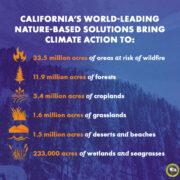
SACRAMENTO – California is taking unprecedented action to strategically harness the power of the equivalent of more than half of its land to fight the climate crisis.
As called for by Governor Gavin Newsom’s California Climate Commitment, the state unveiled 81 targets for nature-based solutions on Monday, April 22 that will help California achieve its world-leading climate goals, including reaching carbon neutrality by 2045.
Nature-based solutions support the ability of lands to absorb more carbon than they release – a critical tool in the state’s climate arsenal. Since 2020, the Newsom Administration has invested approximately $9.6 billion in nature-based solutions that combat the effects of climate change.
“We’re setting aggressive and ambitious new targets to use California’s lands to fight the climate crisis. This scale of action is unprecedented, and yet another example of California punching above its weight. From restoring and conserving lands to greening our urban spaces and treating more acres to prevent wildfires, we’re protecting nature and allowing it to work for our communities,” said Gov. Newsom in a statement released by his office.
What the targets call for by 2045:
- 33.5 million acres managed to reduce wildfire risk, mostly through beneficial fire
- 11.9 million acres of forest managed for biodiversity protection, carbon storage, and water supply protection
- 7.6 million acres conserved with protections
- 3.4 million acres of croplands managed to boost healthy soils, drought resilience, and below-ground biodiversity
- 4.2 million trees planted to protect California communities from the climate crisis, remove carbon and increase access to nature where it’s needed most
- 2.7 million acres of shrublands and chaparral managed for carbon storage, resilience, and habitat connectivity
- 1.6 million acres of grasslands managed to restore native grasslands and protect biodiversity
- 1.5 million acres of sparsely vegetated lands (deserts, beaches, etc.) to protect fragile ecosystems
- 233,000 acres of wetlands and seagrasses managed to protect water supply, deliver carbon benefits, and buffer communities from flooding.
Why California is setting these targets
- For the first time, California’s 2022 Scoping Plan analyzed the amount of greenhouse gas (GHG) emissions produced and absorbed by California’s lands and found that California’s lands currently emit more than they absorb.
- This shift from carbon sink to carbon emitter is largely due to historic land use decisions, including disconnection from beneficial land management practices utilized by California Native American tribes, and the accelerating impacts of climate change.
- Modeling suggests that aggressive near-term efforts to increase climate action on California’s lands will put this sector on the path to course correction.
- The 2022 Scoping Plan set a numeric goal for California’s lands to contribute as much as possible to achieving carbon neutrality by 2045: no more than 4% additional carbon stock losses below 2014 levels from California’s lands by 2045.
(CA Governor’s Office Release)






